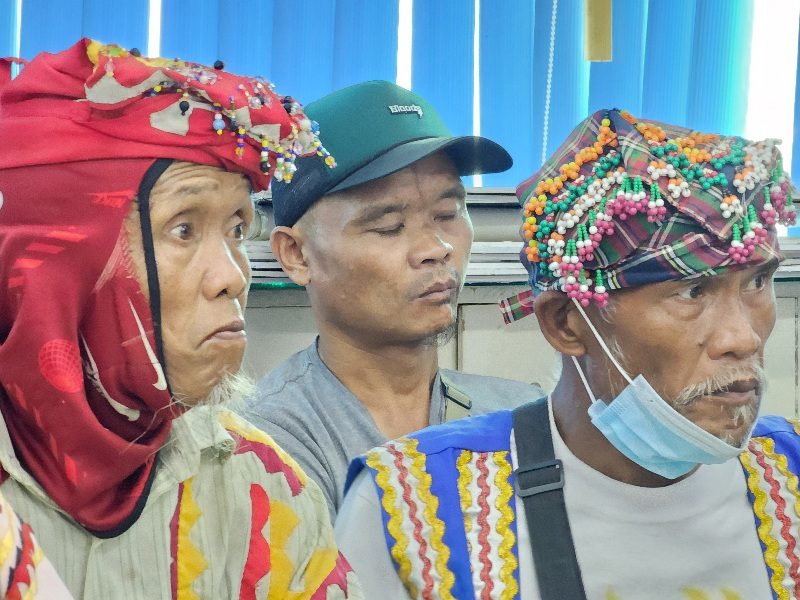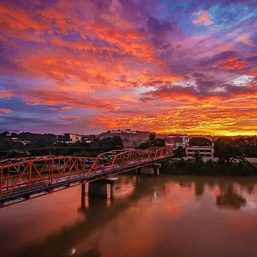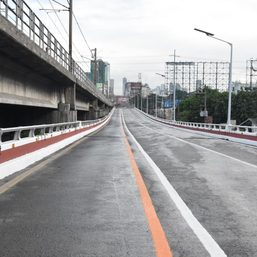SUMMARY
This is AI generated summarization, which may have errors. For context, always refer to the full article.

READ: Part 1 | Higaonons battle for ancestral land in Misamis Oriental for years
Last of 2 parts
CAGAYAN DE ORO, Philippines – Forest areas, sacred sites, and even ancestral burial grounds – cherished land parcels held in deep reverence by the Higaonons – have been destroyed by investors along Route 955, a highway that cuts across villages within the tribe’s 17,558-hectare ancestral domain in Misamis Oriental.
The Higaonon territory used to be a virtual no man’s land and largely undeveloped until the Department of Public Works and Highways (DPWH) constructed the 71-kilometer secondary highway from Villanueva town to Gingoog City.
Since Route 955’s opening in 2014, commercial establishments, mostly built for tourism, have sprouted from Claveria town to Gingoog in Misamis Oriental, near the adjacent Caraga region.
At what cost?
“We are not against development. We welcome it. But the development has also had negative impacts on us. It has facilitated the easy entry and land acquisition by outsiders at our expense,” said Erlinda Malo-ay-Morga, the chairperson of the Mat-i, Man-ibay, Civoleg, and Langguyod Higaonon Tribal Community Incorporated (Mamacila).
Morga said the situation along Route 955 could have been prevented had the National Commission on Indigenous Peoples (NCIP) and other concerned government agencies collaborated to assist them with land segregation and Land Registration Authority (LRA) processes.
Although Mamacila holds a 2009 Certificate of Ancestral Domain Title (CADT), which means collective ownership, the land segregation and LRA registration are still necessary to address conflicts related to overlapping claims and determine the legitimacy of documents held by other groups or individuals.
Segregation here refers to the process of setting apart specific areas exclusively for the use of particular indigenous groups or communities.
Money problems
After years of struggling to assert their rights to their inheritance, Gingoog-based Higaonon leader Gina Limbatao-Javier said she has concluded that ultimately, it all boils down to the color of one’s money.
“The law should be fairly and equally applied, and the IPRA (Indigenous Peoples’ Rights Act) should be implemented harmoniously by government agencies. What happens is that moneyed people go to the DENR (Department of Environment and Natural Resource) to apply for titles. Meanwhile, the IPs (indigenous peoples) have no money. That’s the problem,” Javier said.

The Higaonons and an NCIP official identified the DENR as the government agency responsible for the land conversions taking place within the ancestral domain.
The process involves land reclassification or the conversion from timberland or public domain to alienable and disposable land, thereby enabling titling.
The land conversions and long-delayed land segregation and LRA registration could displace more Lumad families due to the economic boom in the area, they said.
Javier, who serves as the indigenous peoples’ mandatory representative to a village council in Gingoog, said at least 50 Higaonon families were forced to leave their farming community in Sitio Civoleg, Barangay Lunotan, in her city alone.
She said the displacement took place to make way for the development of 76 hectares into a tourist spot by the Gingoog City government. Yet, she said, only less than half of the 76 hectares was titled.
Javier said the local government provided the agriculture-dependent families with small lots in a relocation area, but this gesture was neither appreciated nor seen as compensation by the Higaonons who lost their homes and farms.

Javier said the local government claimed to have obtained a land title in 2021, long after the passage of the IPRA in 1997 and more than a decade after the Higaonons secured their CADT.
“The area is part of our ancestral domain. How were they able to obtain a title when the IPRA is meant to protect us, and we have a CADT?” Javier said.
When Javier and the other Higaonons complained, she said they were merely told by a city hall official to demand answers from the LRA instead.
Caught in the crossfire
The Duterte administration, through Congress, amended old public land and property registration laws in 2021, to improve and harmonize the confirmation process for imperfect land titles.
Yet efforts to harmonize government work and land-use plans saw little progress as prominently shown by the current situation in the Claveria-Gingoog Higaonon ancestral domain.
As early as 2012, the Department of Agrarian Reform (DAR), DENR, NCIP, and LRA came out with a joint administrative order to harmonize their work.
The joint order was formulated to institute corrections of problems resulting from uncoordinated specialized land tenure instruments by the agencies.
“It was a self-addressed message to coordinate their actions and outputs with regard to the submission of land titles to LRA,” said Manuel Uy, advocacy officer of the non-government organization Non-Timber Forest Products Exchange Programme-Philippines, which is helping the Higaonon community.
Government agencies need to get their act together because, according to Uy, indigenous peoples’ communities were always at the losing end as a result of differences among people in government.
“Naiipit kasi ang mga community sa away ng mga ahensiya at ramdam nila na sila ang talo sa gulo (The communities feel trapped in the conflict among agencies, and they sense that they are the ones who lose in the chaos),” Uy told Rappler.
He said Lumad communities, not just Mamacila, have long been appealing to the government agencies to help each other instead for the sake of their communities.
“Kung tutuusin pareho naman silang gobyerno (Come to think of it, they are all part of the government),” he said.
No IP consent
Most of the projects, according to Mamacila, were undertaken without their consent.
Mamacila has also raised concerns about several other land development projects, mostly private initiatives, taking place along the Claveria-Gingoog stretch without the mandatory Free, Prior, and Informed Consent (FPIC) certificates.
The FPIC ensures the right of indigenous peoples to provide or withhold consent to projects or activities that may affect their territories, resources, and cultural heritage.
Uy said the ancestral domain was surveyed by NCIP years ago, and copies of its technical description are with the IP group and the Commission.
“They want to determine the land titles that may have existed even before 2005 when they applied for a CADT. The problem now is that many non-Higaonons have started making land claims within that ancestral domain as soon as the area saw a sudden development,” Uy said.
If there are legitimate claims within the ancestral domain, Uy said the Higaonons will respect the titles.
If legitimate landowners opt to sell their titled property, he said the Higaonon community should have prior rights to reacquire them.
Old and tired
Higaonon elder Perfecto Pinuhan pleaded with the NCIP and other government agencies to halt the runaround his tribal group has faced in their effort to segregate and register their ancestral domain in Misamis Oriental.
An aging Pinuhan said he was among the first Higaonons in the area to work on obtaining their CADT from the NCIP.
The process involved submitting an application and providing evidence of the ancestral domain claim, including historical, cultural, and genealogical proofs. Their application then underwent a tedious process of validation, consultation, and hearings, during which concerned parties were given opportunities to express their views and objections.
Pinuhan and his group had met the requirements, and their collective claim was deemed valid, resulting in the issuance of their CADT in 2009.
The tribal chieftain said he was younger and full of energy back then. But he has now grown old and weary of being given the runaround.
“I have wasted many shoes, but the saddest part is that my teeth have already worn out… I lost my teeth, but it (registration) never arrived,” Pinuhan told Rappler.
For the nth time, he and over a dozen other Higaonons trooped to the NCIP office in Cagayan de Oro to voice their grievances and seek assistance on June 5.
“I ask them to please have mercy,” the 68-year-old Pinuhan, known in his tribe as Datu Mantundahan, told Rappler.
He also said many of those who collaborated with him to persuade the NCIP en banc to grant them the ancestral domain title have already died.
“I don’t want to die without leaving my children and grandchildren the land passed down to me by my ancestors,” Pinuhan said.
Risky investment
Cagayan de Oro-based human rights lawyer Beverly Musni, meanwhile, cautioned that those who acquire land rights or titles within the Higaonon ancestral domain face the risk of paying the IP community for damages and having their titles nullified.
Although not associated with the Mamacila group, Musni pointed out that the CADT represents communal ownership of the land, and that no individual, even a Higaonon, can sell or transfer rights over parcels of land within the ancestral domain.
She said decisions regarding its use should be made collectively, and the Higaonons can only assign their rights as a group.
“But selling is definitely out of the question,” she said.
Musni called on the government to check the new claims and examine the supporting documents to ascertain the dates of the alleged land ownership titles.
“Even if antedated, a paper trail would reveal when the claims were made. It wouldn’t be wise to consider buying land there,” she said. “They collectively own it. Therefore, those who invest in land there are assuming significant risks. Buy at your own risk.” – Rappler.com
1 comment
How does this make you feel?























“Government agencies need to get their act together,” but when money speaks, the moneyed individuals or groups will get what they want. IPs should file a complaint against NCIP for Gross Negligence to teach such agency a lesson and DENR for the appropriate charge(s). If the Government would not heed their complaint(s), perhaps, they know what is their Last Resort.